Research on the Determination Method of Aircraft Flight Safety Boundaries Based on Adaptive Control
Abstract
1. Introduction
- Referring to the definition of LOC runaway envelope, this paper innovatively proposes a multi-parameter combination dynamic envelope concept and uses the reachable set theory to calculate the dynamic envelope under different degrees of icing conditions, which will be extended from a single parameter to characterize the flight envelope.
- Using the idea of control limit and command limit, a flight safety boundary protection system based on L1 adaptive control is designed. Through simulation verification and a wind tunnel virtual flight test, it is verified that the designed boundary protection system can effectively limit the key safety parameters within the safety boundary, which provides an effective safety guarantee for the background aircraft flying with ice.
2. Definition of Flight Safety Envelope Curve
3. Method of Determining Flight Safety Boundaries
3.1. Reachable Set
3.2. Real-Time Flight Simulation Platform
3.3. Construction of 3D Geometric Digital Model of Background Aircraft Icing Configuration
3.4. Determination of Aircraft Dynamics Envelope under Icing Conditions Case
- Determination of longitudinal dynamics envelope of aircraft under icing conditions
- 2.
- Determination of aircraft transverse heading dynamics envelope under icing conditions
4. L1 Adaptive Stability Augmentation Control Based on Flight Safety Boundaries Protection Method
- Flight safety boundaries determination module. Based on the determination method of flight safety boundaries given in the previous paper, the combination boundaries of airspeed, attack angle, sideslip angle, and roll angle are determined under different icing levels (as shown in the dashed block on the left).
- Envelope restriction protection module of critical flight parameters. This module determines the envelope limit value of key parameters given by the module according to the flight safety boundaries, and uses the command limit to achieve the protection of key safety parameters (as shown in the dashed block on the right). Take the attack angle envelope restriction as an example, the specific design method and framework of the attack angle protection module are given, as shown in Figure 8 below.
- 3
- The flight controller module based on L1 adaptive stability augmentation control. The module takes the values of key safety parameters output from the envelope limit protection module as input commands, obtains the rudder deflection of the control rudder surface by solving the control law, and inputs them into the aircraft six-degree-of-freedom full-scale dynamics equations for calculation to obtain the dynamic response of the flight attitude and other state parameters.
5. Simulation Verification of Envelope Protection System Based on L1 Adaptive Stability Augmentation Control
Envelope Protection Test Verification based on Virtual Test Flight in Wind Tunnel
6. Discussion
Author Contributions
Funding
Institutional Review Board Statement
Informed Consent Statement
Data Availability Statement
Conflicts of Interest
References
- Fuller, J.G.; Hook, L.R. Understanding General Aviation Accidents in Terms of Safety Systems. In Proceedings of the 39th AIAA/IEEE Digital Avionics Systems Conference (DASC), San Antonio, TX, USA, 11–15 October 2020. [Google Scholar]
- Green, N.D.C.; Ford, S.A. G-induced loss of consciousness: Retrospective survey results from 2259 military aircrew. Aviat. Space Environ. Med. 2006, 77, 619–623. [Google Scholar]
- Hess, R.A. Modeling Human Pilot Adaptation to Flight Control Anomalies and Changing Task Demands. J. Guid. Control Dyn. 2016, 39, 655–666. [Google Scholar] [CrossRef]
- Lyons, T.J.; Kraft, N.O.; Copley, G.B.; Davenport, C.; Grayson, K.; Binder, H. Analysis of mission and aircraft factors in g-induced loss of consciousness in the USAF: 1982–2002. Aviat. Space Environ. Med. 2004, 75, 479–482. [Google Scholar] [PubMed]
- Ud-Din, S.; Yoon, Y. Analysis of Loss of Control Parameters for Aircraft Maneuvering in General Aviation. J. Adv. Transp. 2018, 2018, 7865362. [Google Scholar] [CrossRef]
- Wang, K.; Xue, Y.; Tian, H.F.; Wang, M.S.; Wang, X.L. The Impact of Icing on the Airfoil on the Lift-Drag Characteristics and Maneuverability Characteristics. Math. Probl. Eng. 2021, 2021, 68740. [Google Scholar] [CrossRef]
- Wang, Y.; Shao, P.; Wu, Q.; Chen, M. Reliability analysis for a hypersonic aircraft’s wing spar. Aircr. Eng. Aerosp. Technol. 2019, 91, 549–557. [Google Scholar] [CrossRef]
- Geng, Q.; Duan, H.; Li, S. Dynamic Fault Tree Analysis Approach to Safety Analysis of Civil Aircraft. In Proceedings of the 6th IEEE Conference on Industrial Electronics and Applications (ICIEA), Beijing, China, 21–23 June 2011; pp. 1443–1448. [Google Scholar]
- Zhang, J.; Jiang, Y.; Wu, S.; Li, X.; Luo, H.; Yin, S. Prediction of remaining useful life based on bidirectional gated recurrent unit with temporal self-attention mechanism. Reliab. Eng. Syst. Saf. 2022, 221, 108297. [Google Scholar] [CrossRef]
- Belcastro, C.M.; Foster, J.V.; Shah, G.H.; Gregory, I.M.; Cox, D.E.; Crider, D.A.; Groff, L.; Newman, R.L.; Klyde, D.H. Aircraft Loss of Control Problem Analysis and Research Toward a Holistic Solution. J. Guid. Control Dyn. 2017, 40, 733–775. [Google Scholar] [CrossRef]
- Guo, K.; Liu, L.; Shi, S.; Liu, D.; Peng, X. UAV Sensor Fault Detection Using a Classifier without Negative Samples: A Local Density Regulated Optimization Algorithm. Sensors 2019, 19, 771. [Google Scholar] [CrossRef]
- Li, X.; Xu, X.; Wang, C.; Li, D. Establishment of Flight Rerouting Area and Air Route Planning based on Convex Polygon. In Proceedings of the 20th Chinese Control and Decision Conference, Yantai, China, 2–4 July 2008; pp. 3083–3088. [Google Scholar]
- Balachandran, S.; Atkins, E.M. Flight Safety Assessment and Management for Takeoff Using Deterministic Moore Machines. J. Aerosp. Inf. Syst. 2015, 12, 599–615. [Google Scholar] [CrossRef]
- Chen, D.; Luo, F.; Feng, Y. Analysis of Flight Safety Risk Coupling Based on Fuzzy Sets and Complex Network. In Proceedings of the 20th International Annual Conference on Management Science and Engineering, Harbin, China, 17–19 July 2013; pp. 329–334. [Google Scholar]
- Gan, X.-S.; Cui, H.-L.; Wu, Y.-R. Study on Mechanical Engineering for Flight with Flight Safety Evaluation Method on Relevance Vector Machine. In Proceedings of the International Conference on Mechanical Engineering, Civil Engineering and Material Engineering (MECEM 2013), Hefei, China, 27–28 October 2014; pp. 70–73. [Google Scholar]
- Gao, J.; Zhang, H.; Wang, Q.; Min, G. Safety Risk Evaluation of Aviation System Based on Fuzzy Evidential Reasoning Method. In Proceedings of the 6th International Conference on Electromechanical Control Technology and Transportation (ICECTT), Chongqing, China, 14–16 May 2022. [Google Scholar]
- Jiao, J.; Zhao, T.D.; Wang, W. Flight Safety Simulation System Based on Hybrid Dynamic System. In Proceedings of the 55th Annual Reliability and Maintainability Symposium, Ft Worth, TX, USA, 26–29 January 2009; pp. 236–242. [Google Scholar]
- Jing, H.-S.; Sheng, C.-S.; Lin, Y.-F. Flight Safety Margin Theory—A Theory for the Engineering Analysis of Flight Safety. In Proceedings of the 12th International Conference on Engineering Psychology and Cognitive Ergonomics (EPCE) Held as Part of 17th International Conference on Human-Computer Interaction (HCI International), Los Angeles, CA, USA, 2–7 August 2015; pp. 377–387. [Google Scholar]
- Lewitowicz, J.; Rutkowski, S.; Tomaska, R.; Zyluk, A. The mathematical formula of safety of aircrafts. In Proceedings of the European Safety and Reliability Conference (Esrel), Wroclaw, Poland, 14–18 September 2015; pp. 141–142. [Google Scholar]
- Li, Z.; Xu, H.; Xue, Y.; Pei, B. Study on flight safety manipulation space under complex conditions. Proc. Inst. Mech. Eng. Part G J. Aerosp. Eng. 2019, 233, 725–735. [Google Scholar] [CrossRef]
- Meng, F.; Wang, D.; Yang, P.; Xie, G.; Guo, F. Application of Sum-of-Squares Method in Estimation of Region of Attraction for Nonlinear Polynomial Systems. IEEE Access 2020, 8, 14234–14243. [Google Scholar] [CrossRef]
- Vora, A.S.; Sinha, N.K. Direct Methodology for Constrained System Analysis with Applications to Aircraft Dynamics. J. Aircr. 2017, 54, 2378–2385. [Google Scholar] [CrossRef]
- Yu, Z.; Li, Y.; Zhang, Z.; Xu, W.; Dong, Z. Online Safe Flight Envelope Protection for Icing Aircraft Based on Reachability Analysis. Int. J. Aeronaut. Space Sci. 2020, 21, 1174–1184. [Google Scholar] [CrossRef]
- Zhou, C.; Li, Y.; Zheng, W.; Wu, P.; Dong, Z. Safety Analysis for Icing Aircraft during Landing Phase Based on Reachability Analysis. Math. Probl. Eng. 2018, 2018, 3728241. [Google Scholar] [CrossRef]
- Zhou, C.; Li, Y.; Zheng, W.; Wu, P. Aircraft safety analysis based on differential manifold theory and bifurcation method. Front. Inf. Technol. Electron. Eng. 2019, 20, 292–299. [Google Scholar] [CrossRef]
- Zheng, W.; Li, Y.H.; Qu, L.; Yuan, G. Dynamic Envelope Determination Based on Differential Manifold Theory. J. Aircr. 2017, 54, 2003–2007. [Google Scholar] [CrossRef]
- Khodadadi, L.; Samadi, B.; Khaloozadeh, H. Estimation of region of attraction for polynomial nonlinear systems: A numerical method. Isa Trans. 2014, 53, 25–32. [Google Scholar] [CrossRef]
- Norouzi, R.; Kosari, A.; Sabour, M.H. Real time estimation of impaired aircraft flight envelope using feedforward neural networks. Aerosp. Sci. Technol. 2019, 90, 434–451. [Google Scholar] [CrossRef]
- Lygeros, J.; Ieee, I. On the relation of reachability to minimum cost optimal control. In Proceedings of the 41st IEEE Conference on Decision and Control, Las Vegas, NV, USA, 10–13 December 2002; pp. 1910–1915. [Google Scholar]
- Nabi, H.N.; Lombaerts, T.; Zhang, Y.; van Kampen, E.; Chu, Q.P.; de Visser, C.C. Effects of Structural Failure on the Safe Flight Envelope of Aircraft. J. Guid. Control Dyn. 2018, 41, 1257–1275. [Google Scholar] [CrossRef]
- Wei, Y.; Xu, H.; Xue, Y.; Duan, X. Quantitative assessment and visualization of flight risk induced by coupled multi-factor under icing conditions. Chin. J. Aeronaut. 2020, 33, 2146–2161. [Google Scholar] [CrossRef]
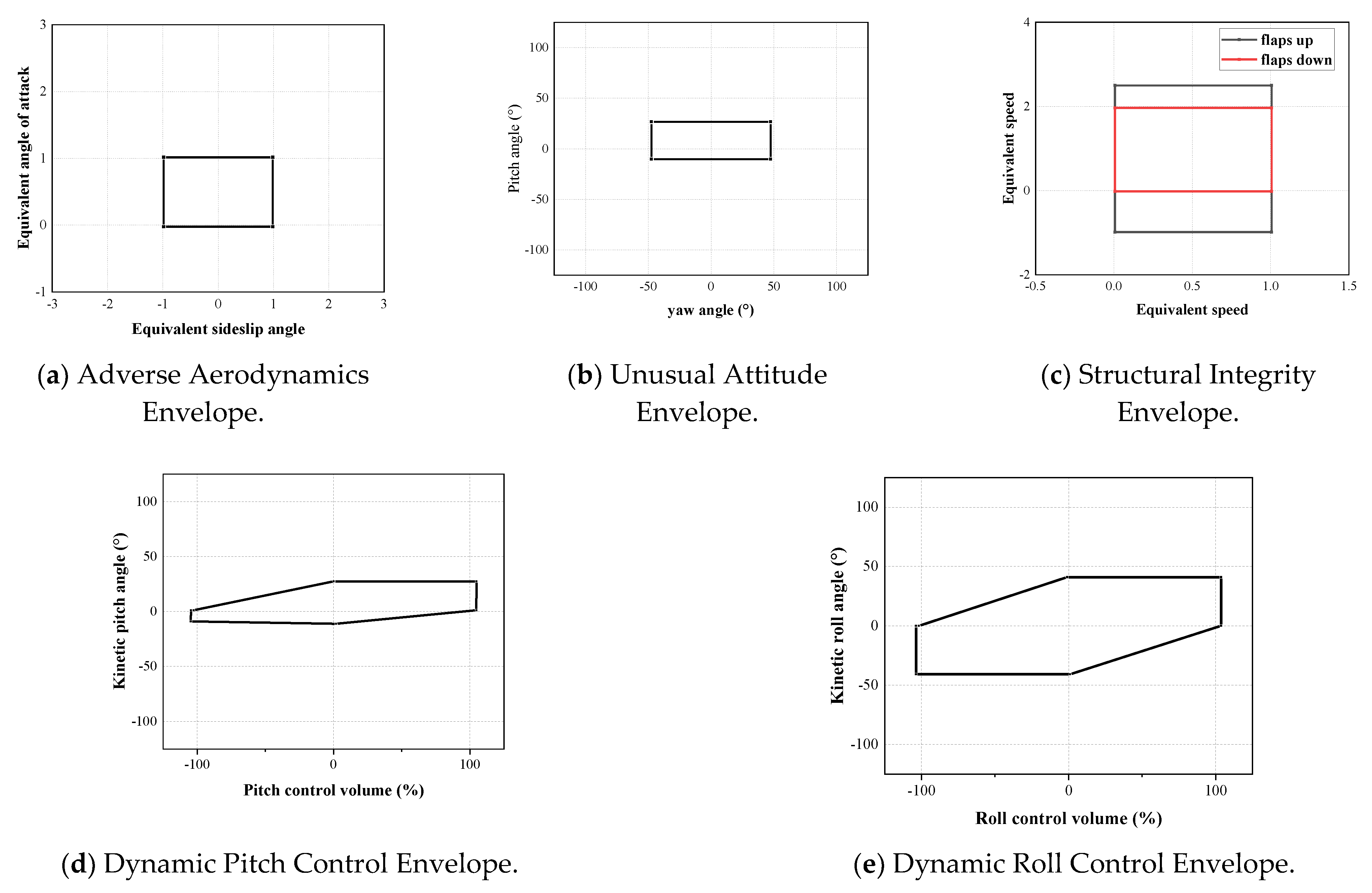

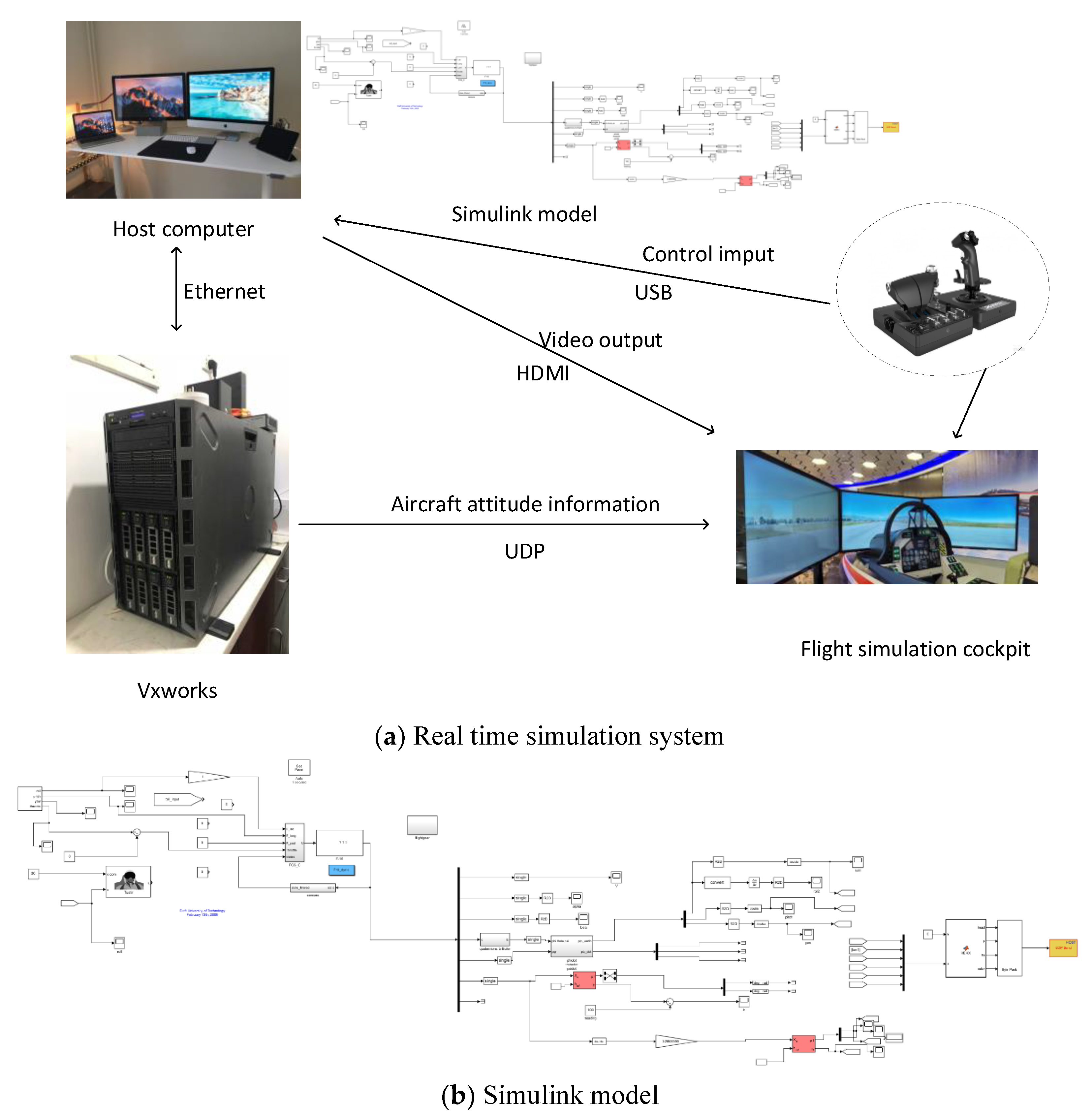
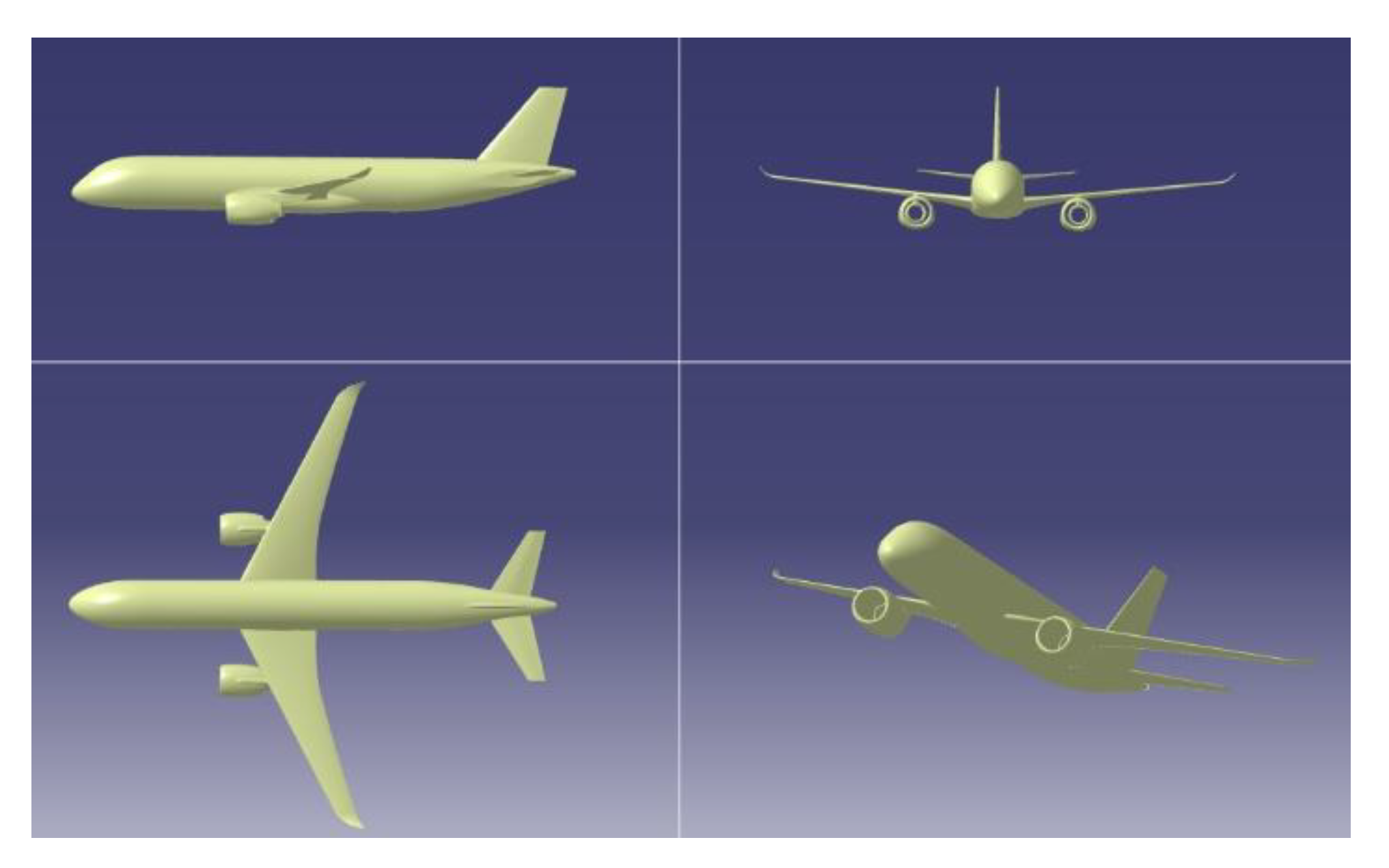
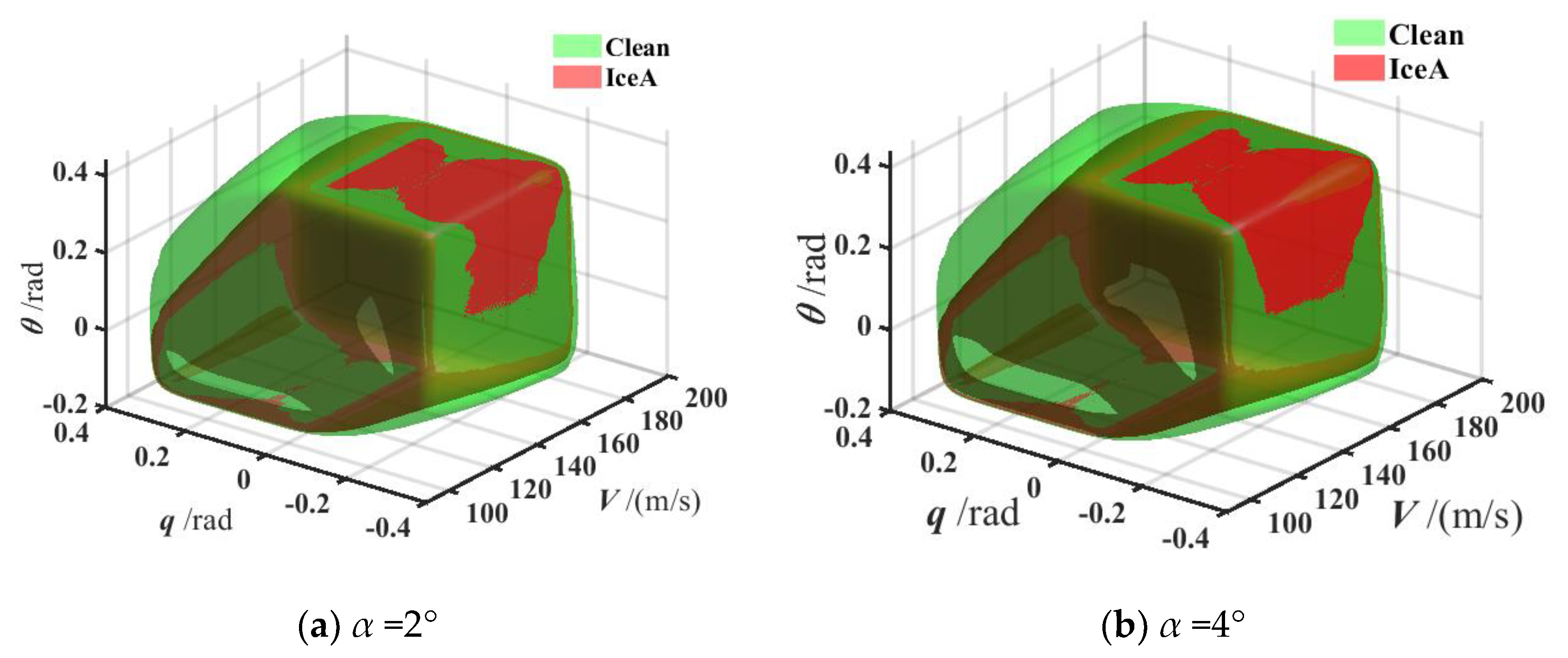
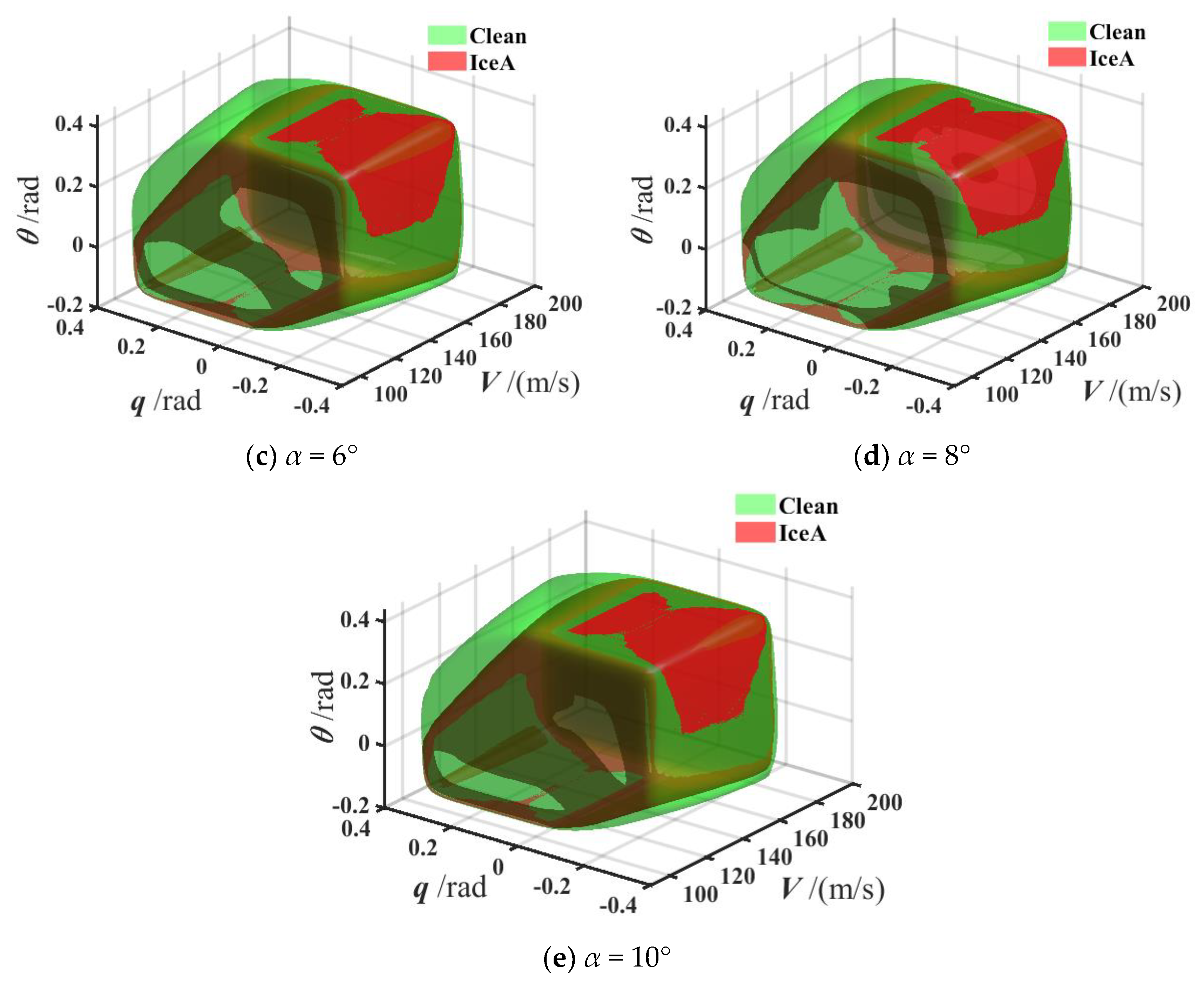
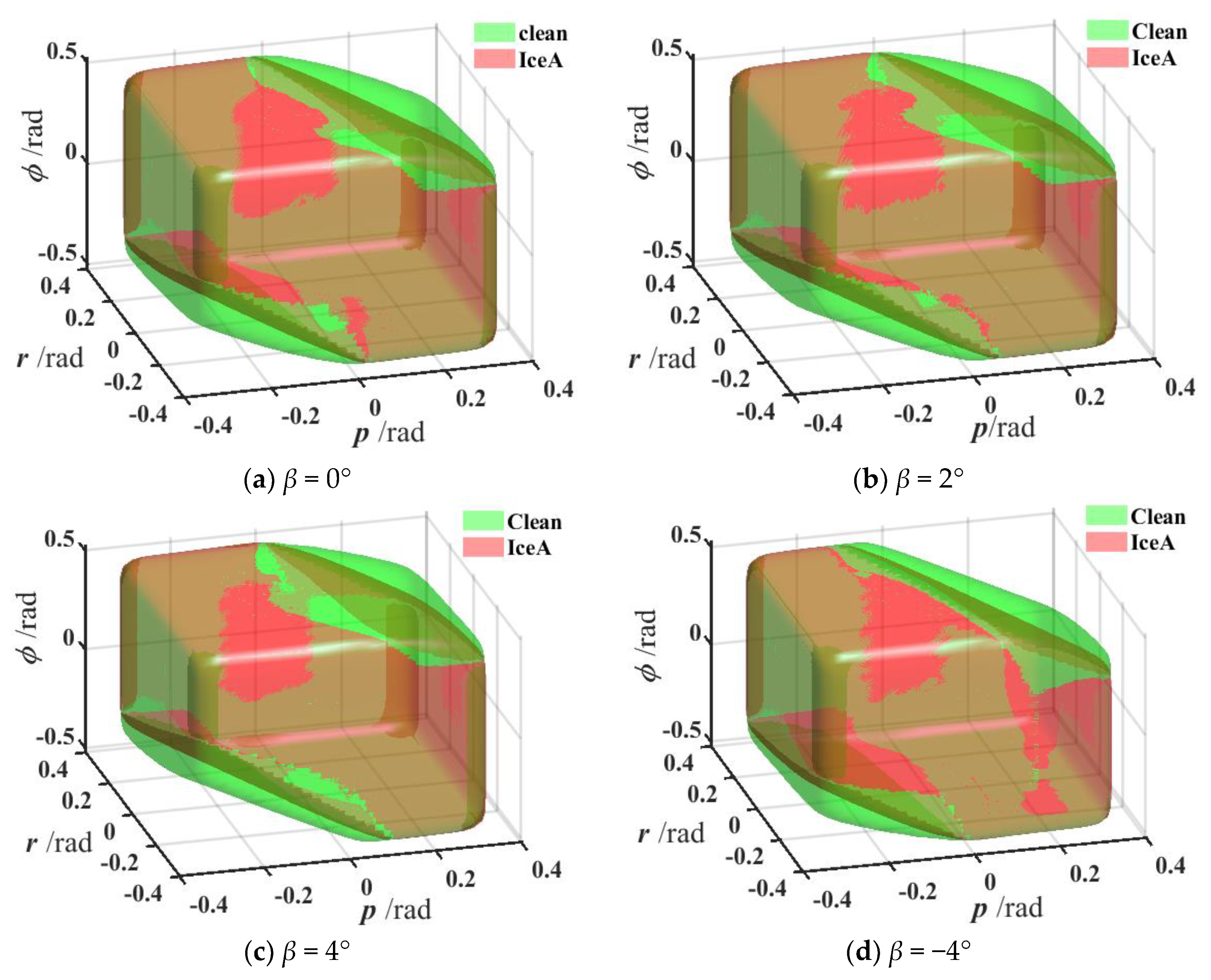
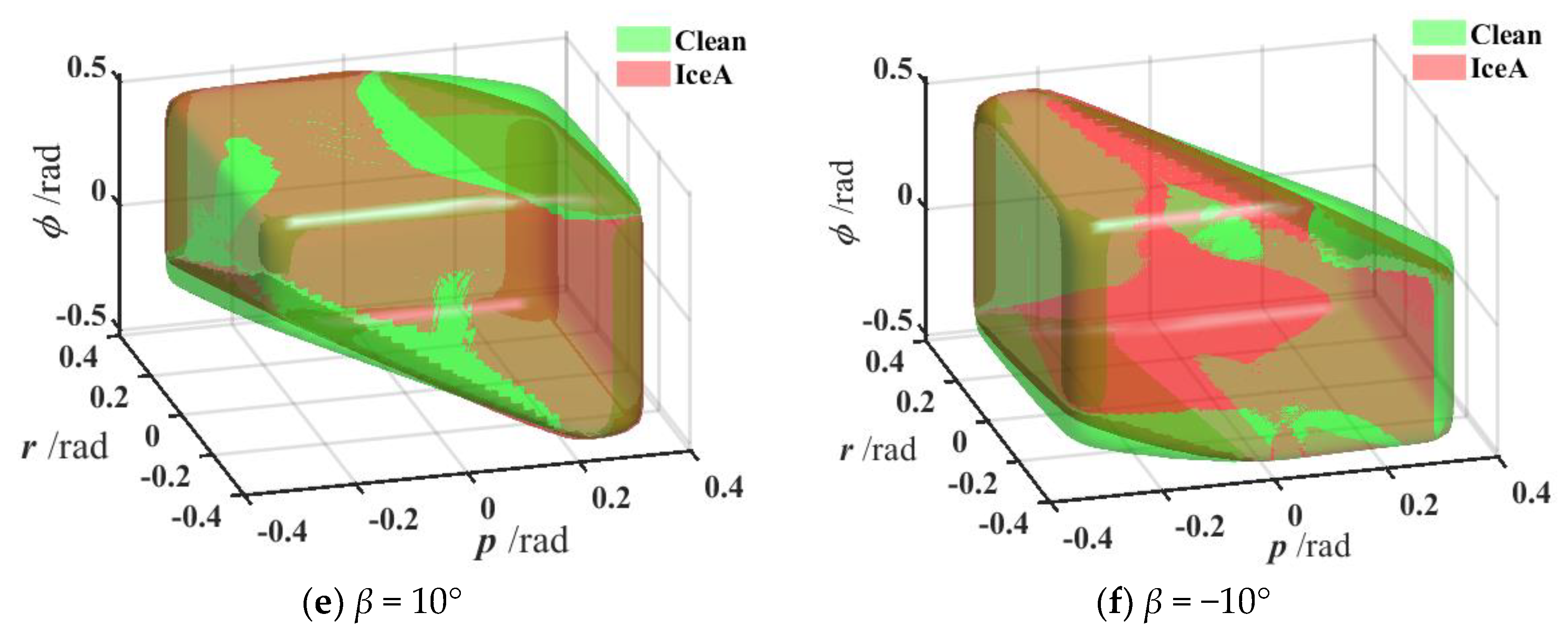
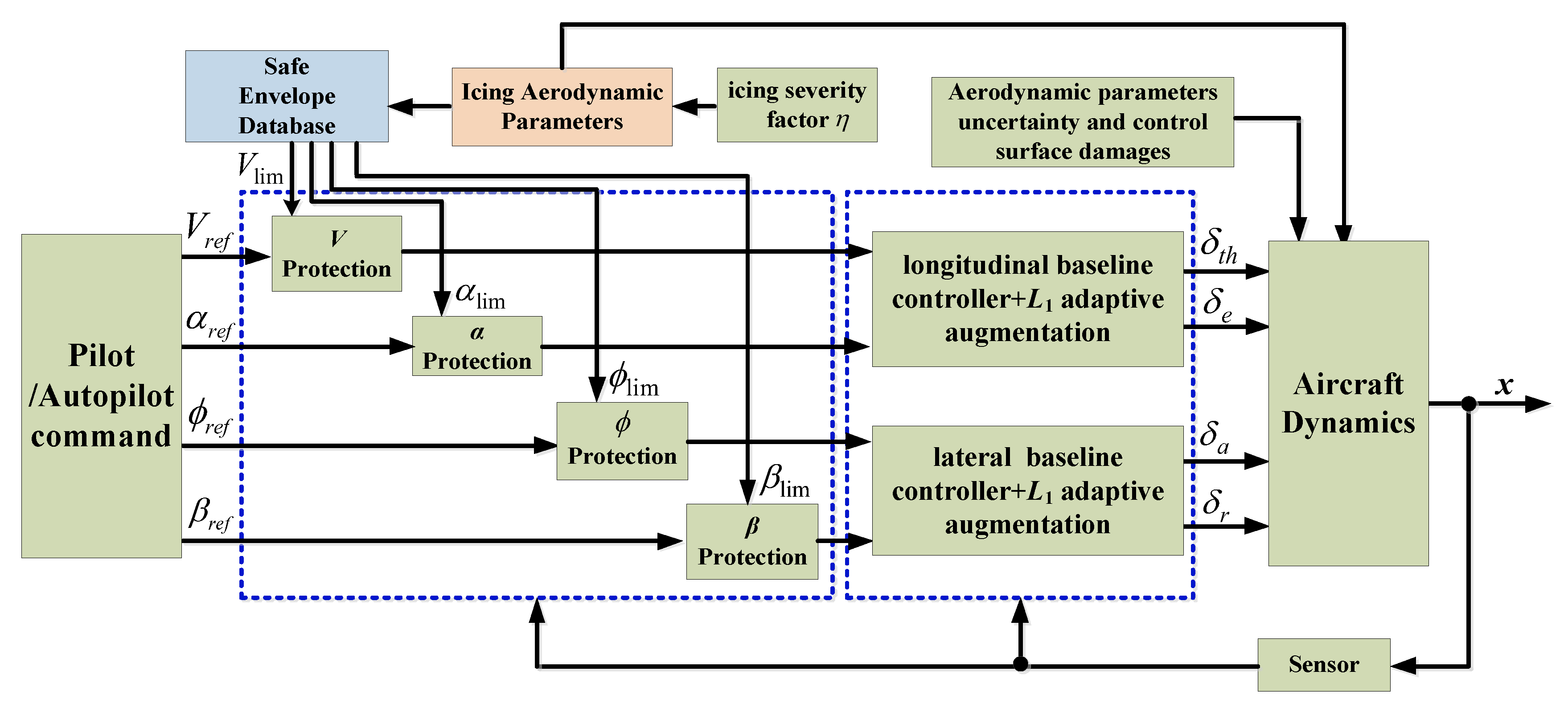
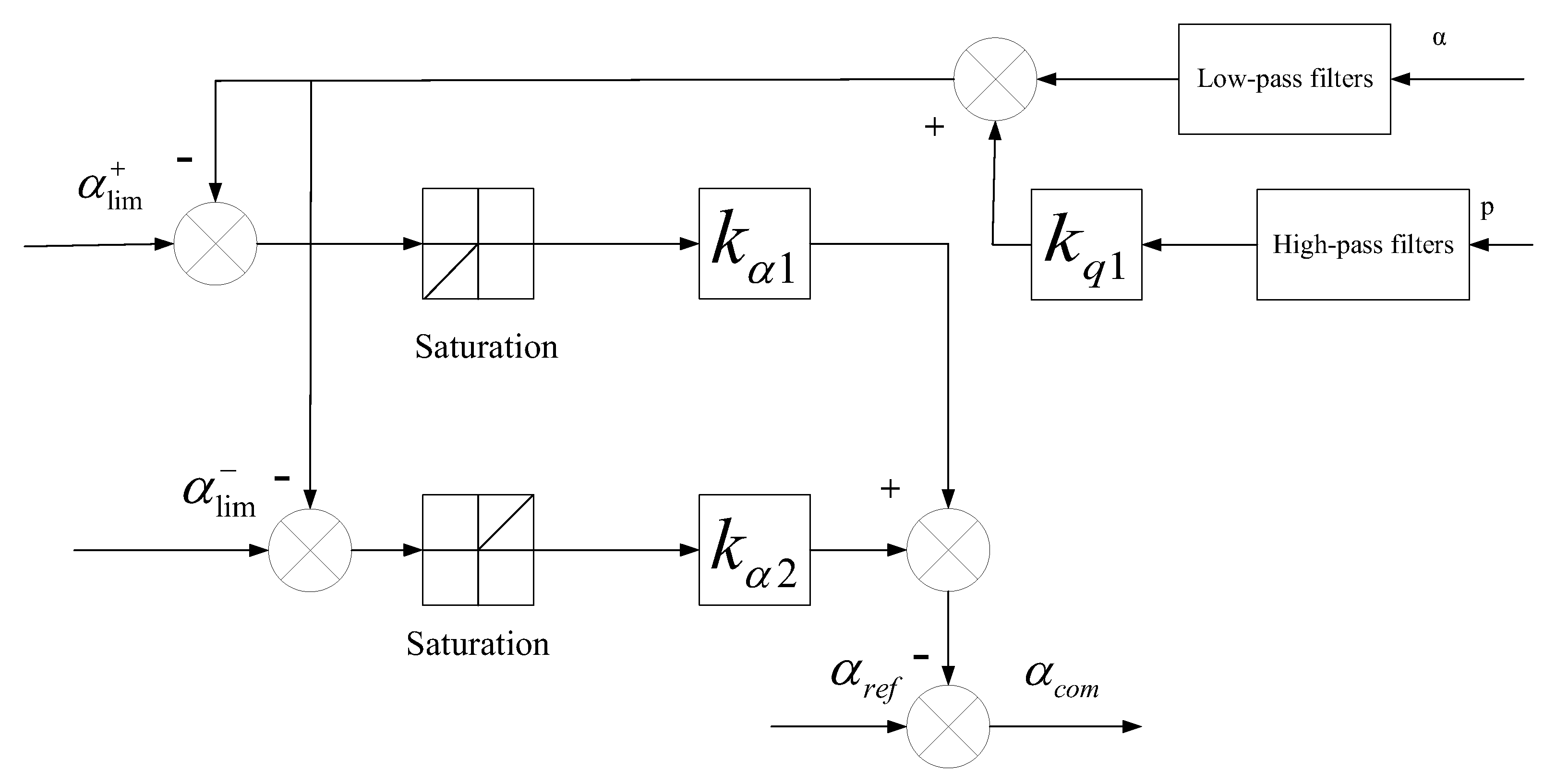

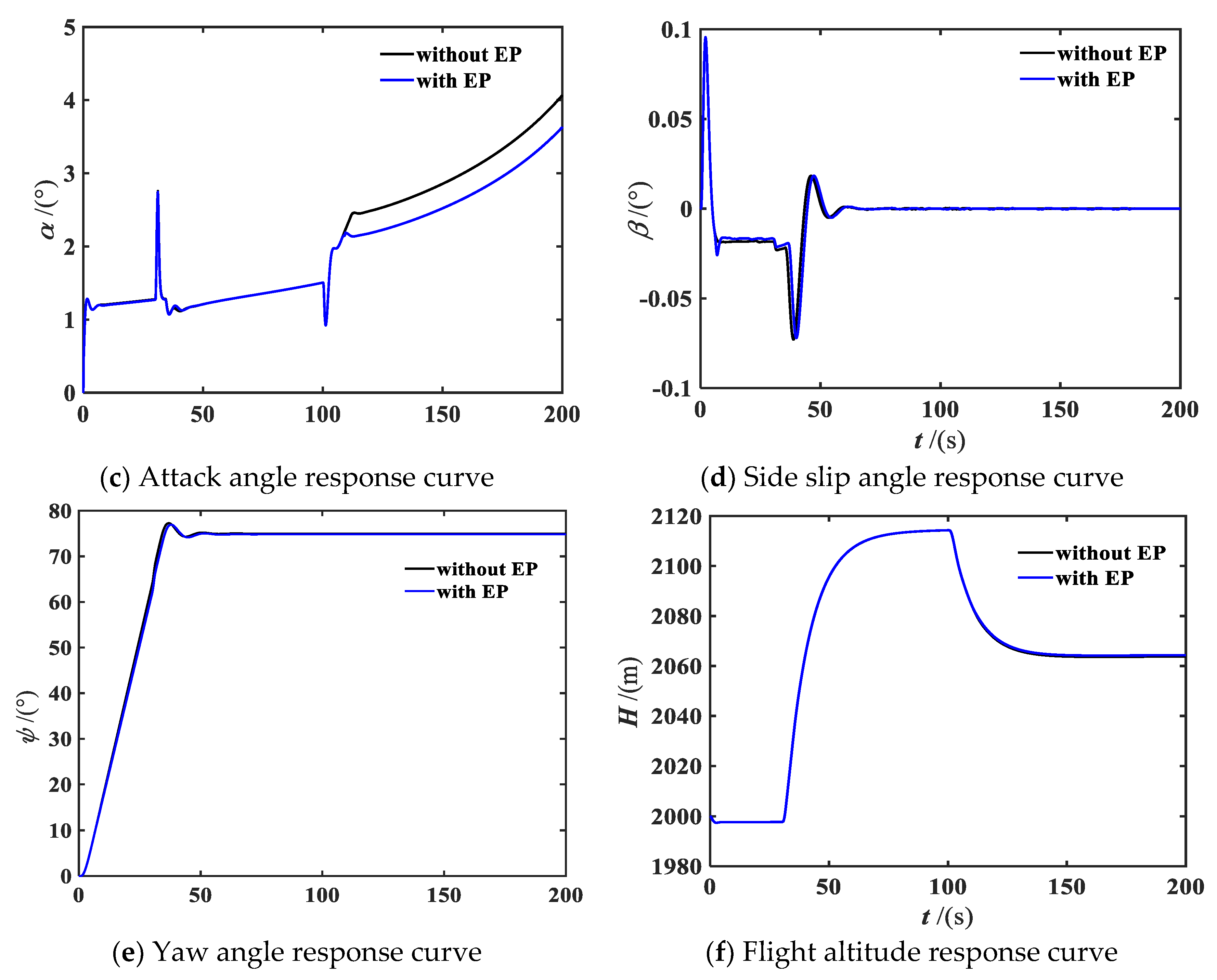

| Name | Symbol | Numerical Value | Unit |
|---|---|---|---|
| aircraft length | L | 38.2 | m |
| wing span | b | 34.10 | m |
| wing area | S | 124.00 | m2 |
| average aerodynamic chord | 4.15 | m | |
| center of mass position | xcg | 0.2199 | m |
| center of mass reference position | xcgr | 0.25 | m |
| maximum take-off weight of the aircraft | m | 72,000 | kg |
| moment of inertia of x-axis | Ixx | 1,658,755 | kg·m2 |
| moment of inertia of y-axis | Iyy | 2,392,630 | kg·m2 |
| moment of inertia of z-axis | Izz | 384,6326 | kg·m2 |
| x-axis inertia | Ixz | 155,000 | kg·m2 |
| L1 Adaptive Stability Augmentation Control Method | |||
|---|---|---|---|
| advantage | The design is simple, the control law is simple, and the calculation amount is small. | Simple design, safe and reliable. | High applicability, boundary protection can perform real-time operations, and can protect most faults. |
| disadvantage | It can only limit the flight parameter of the angle of attack, and cannot deal with complex faults. | The amount of control is small and cannot be used for complex faults. | The control law design is complex and requires more envelope data. |
Publisher’s Note: MDPI stays neutral with regard to jurisdictional claims in published maps and institutional affiliations. |
© 2022 by the authors. Licensee MDPI, Basel, Switzerland. This article is an open access article distributed under the terms and conditions of the Creative Commons Attribution (CC BY) license (https://creativecommons.org/licenses/by/4.0/).
Share and Cite
Wang, M.; Xue, Y.; Wang, K. Research on the Determination Method of Aircraft Flight Safety Boundaries Based on Adaptive Control. Electronics 2022, 11, 3595. https://doi.org/10.3390/electronics11213595
Wang M, Xue Y, Wang K. Research on the Determination Method of Aircraft Flight Safety Boundaries Based on Adaptive Control. Electronics. 2022; 11(21):3595. https://doi.org/10.3390/electronics11213595
Chicago/Turabian StyleWang, Miaosen, Yuan Xue, and Kang Wang. 2022. "Research on the Determination Method of Aircraft Flight Safety Boundaries Based on Adaptive Control" Electronics 11, no. 21: 3595. https://doi.org/10.3390/electronics11213595
APA StyleWang, M., Xue, Y., & Wang, K. (2022). Research on the Determination Method of Aircraft Flight Safety Boundaries Based on Adaptive Control. Electronics, 11(21), 3595. https://doi.org/10.3390/electronics11213595





